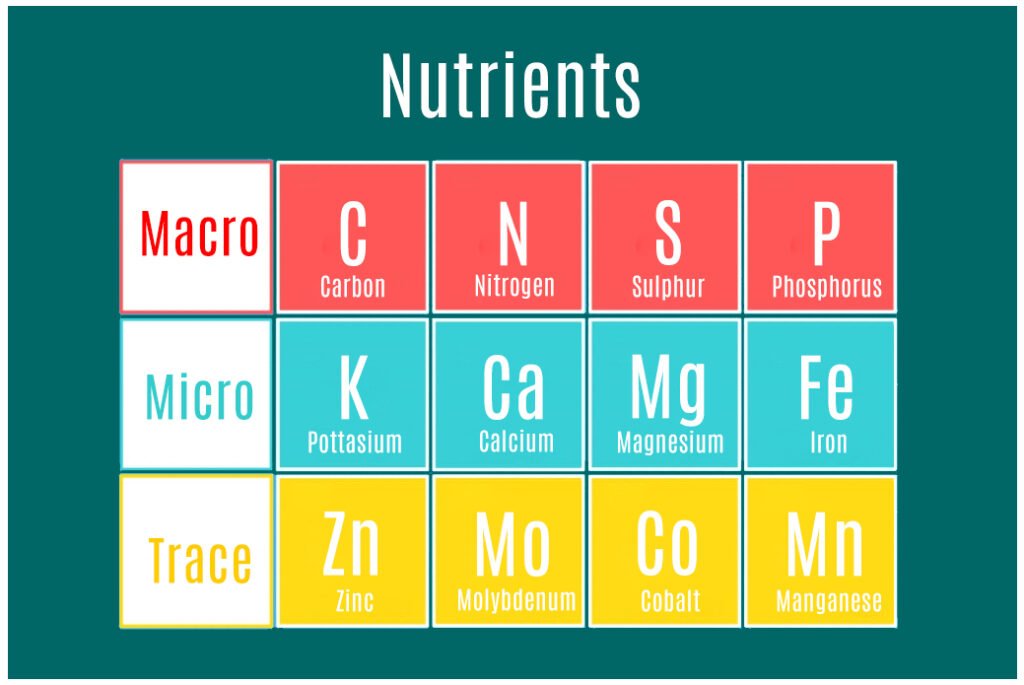know about the details of nutrients and media types such as macronutrients and micronutrients
Nutrients and Media
The substances from which the microbes synthesise new cellular materials and obtain energy are called nutrients.
These nutrients must be supplied as utilisable compounds that take part in the synthesis of new cellular compounds.
Types of Nutrients
The three different types of nutrients are as follows
- Macronutrients
- Micronutrients
- Trace elements

Macronutrients
Macronutrients are nutrients required in relatively large quantities. Macronutrients are the primary building blocks molecules for the growth of microbes and play an essential role in cell structure and metabolism and are weighed in grams per litre.
The significant macronutrients are Carbon (C), Nitrogen (N), Sulphur (S) and Phosphorus (P).
Carbon Source
Carbon source forms the basic skeleton for all organic molecules. These carbon-containing compounds are the energy source to synthesise new cellular components.
The different types of carbohydrates used are Glucose, Fructose and Starch.
Nitrogen Source
Nitrogen is the major component of amino acids and proteins and uses nitrogen to synthesise various enzymes. Nitrogen is the source present in nutrients and media to provide nutrition like protein.
When hydrolysed by enzymes, it breaks down into peptides and then into amino acids.
Peptone is a standard universal ingredient used as a nitrogen source in the preparation of all media.
Sulphur Source
Sulphur is the main constituent present in nutrients and media of many sulphur-containing amino acids like Cysteine, Methionine.
Microbes use sulphur to make the components of coenzymes.
Phosphorus Source
Microbes obtain phosphates to synthesise PO4 ions to prepare teichoic acids, ATP, phospholipids, nucleic acids. ATP is an essential source of energy. Microbes accumulate PO4 granules in the form of metachromatic granules found in Corynebacterium diphtheriae.
Micronutrients
Micronutrients are present in nutrients and media required in relatively smaller quantities when compared to macronutrients.
They are the minor components of building block materials but are still essential for the growth of the microbes and are generally weighed in milligrams per litre.
The significant micronutrients are Potassium (K), Calcium (Ca), Magnesium (Mg), Iron (Fe).
Potassium
Potassium is the principal source present in nutrients and media to provide inorganic cation in the cell and is required for ribosomes and enzymatic functions and the cofactors for some enzymes.
Calcium
Calcium acts as a cofactor acting as the cellular cation. During unfavourable conditions, it helps to form heat resistant spores. Calcium is deposited in the form of DPA.
Magnesium
Magnesium acts as an essential cellular cation, serving as a cofactor for many enzymatic functions, binding enzymes to the substrates and forming an Mg complex with ATP.
Iron
Iron is a vital constituent of cytochromes and other proteins and serves as a cofactor for many enzymatic functions. It is available to the cell in the form of siderophores.
Trace Elements
The nutrients and media which are used in tiny traces are trace elements and serve as a cofactor for many enzymatic functions. Generally, weighed in micrograms per litre.
The significant trace elements are Zinc (Zn), Molybdenum (Mo), Cobalt (Co), Manganese (Mg), Nickel (Ni).
Zinc
Zinc is used by the microbial cell for DNA & RNA polymerase enzymatic functions. It also helps in producing essential metabolites.
Molybdenum
Molybdenum is an essential component of Ferredoxin in the Nitrogenase enzyme present in all nitrogen-fixing bacteria. (Rhizobium)
Cobalt
Cobalt is an essential vital component of the Vitamin B12 molecule.
Manganese
Manganese serves as an alternate capacity for Magnesium deficiency. Many soil bacteria reduce Mn+4 to Mn+2 and are also used in the synthesis of metabolites like antibiotics.
Nickel
Nickel is a cofactor for many enzymes.
For more details about various courses, check out Ampersand Academy.